

This is the first machine I've looked closely at that came with Windows 8 pre-installed. All the other machines were ones were clean installs of Windows 8 from the Microsoft disc. Once it started (and I installed FastStone Capture so I could get all these screen shots), this is what I saw:
The first thing I want to do is install a Start Button (see adding the Classic (Shell) Start Button). I have the install program on an external drive, but how do I get the installation started? It's no wonder people find Windows 8 difficult (impossible) to use. On all the other Windows 8 machines I have there were initially lots of buttons on the Windows 8 Start Screen for things like Computer, Control Panel, etc. You could just press one of those and you were back on familar ground (and the ones you used frequently you would just move over to the left so you didn't have to scroll to find them). Here the answer was to go to one of the right hand corners to make the Charms bar pop-out, and press the Search Icon. The search defaults to Apps, so if I moved my cursor to the bottom middle of the screen the scroll bar appeared and if I started moving it the search dialog on the right-hand side of the screen disappeared and I could see all the Win 8 Apps and other standard programs that were installed on the machine:
(To see full-size versions of many the screen shots in this discussion, just click on the image.)
In the Windows System category, I could then click on "Computer" and I was back on the Desktop with Windows Explorer open just like if you clicked on Computer from the Vista or Windows 7 Start Button Menu:
(To see full-size versions of many the screen shots in this discussion, just click on the image.)
Vista came with a "Welcome Center" which gave you tours showing you how to use the new features that was there when you first started it until you turned it off. The closest equivalent I can find is to do Search (as above) and then click on "Help and Support" in the Windows System catagory, although it's not clear to me how much "Help" you get if you're not connected to the internet.
In the past when I've setup a new machine with Windows pre-loaded, it immediately wants you to activate the free trail of whatever Anti-virus software they've included:
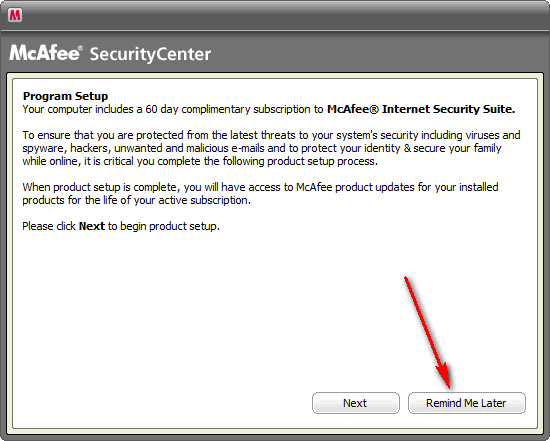
This machine included a 30-day trail of McAfee, and it was already activated, no window like this appeared. If it does, I recommend you ignore it for now. Even if you want to take them up on their trial offer, it's too soon to register. You need to get your internet connection working first. I just said to remind me later and it went away. BTY, McAfee isn't a bad product, someone I recommend for building custom computers likes it enough to include licensed (one-year) copy on machines he builds. See my page on Safe Computing to see which product I really recommend (none of them).
On my external drive I have a "Toolkit" folder with all the programs I frequently install on machines. I opened that folder and started the install:
In the Custom Setup dialog be sure to turn off the install of the Classic Explorer, IE9 and Updater. ONLY install the Classic Start Menu (see adding the Classic (Shell) Start Button). On that page also note the settings that need to be changed on various option tabs, I don't think the defaults are appropriate for Windows 8.
When I installed the first program on this machine, I noticed that extensions where hidden (as they always are on new machines). I think it's very foolish to hide these extensions (someone probably thought it made computers look simpler, but actually hiding them makes things more confusing). Here's what the Toolkit folder on my External Drive looked like (I had programs I had previously downloaded when I had a high-speed internet connection stored here):
Most of these files are .EXE files, but as you can see the extensions are hidden and it's not obvious ... I know, you can look at "Type" column, but who looks there and who knows what "Application" means? I fix this "problem" by clicking on the View tab and then on Options.
The menu looks like this:
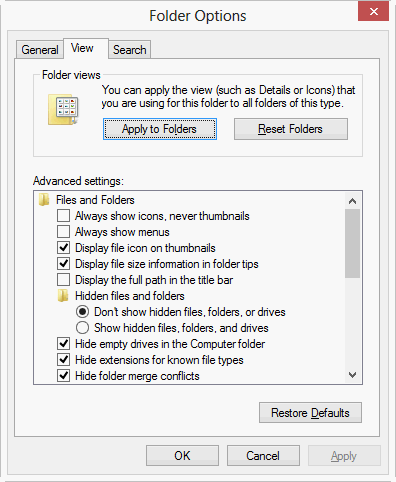
I usually make two changes. I choose the radio button that says "Show hidden files and folders", and I un-check the box that says "Hide extensions for known file types". Some novice users don't want to see hidden files, but sooner or later you may need to, so you might as well get use to them ... if you don't, by the time you need to see them you'll have forgotten where this option is.

Next I installed FastStone Image Viewer (a free program I highly recommend) and got all the warning messages Windows added starting with Vista. Since the stupid messages totally take over your screen, I can't even get a screen shot to show you what they look like. At first I thought they might be a good idea, but even if you turn them off you still get a warning when running a .EXE program. Leaving them on leads to two extra messages EVERY time you change anything: install a program, modify your menus, change your configuration. I now turn off User Account Control immediately and leave it off. Do this by going to the Control Panel, scrolling down and clicking on User Accounts:
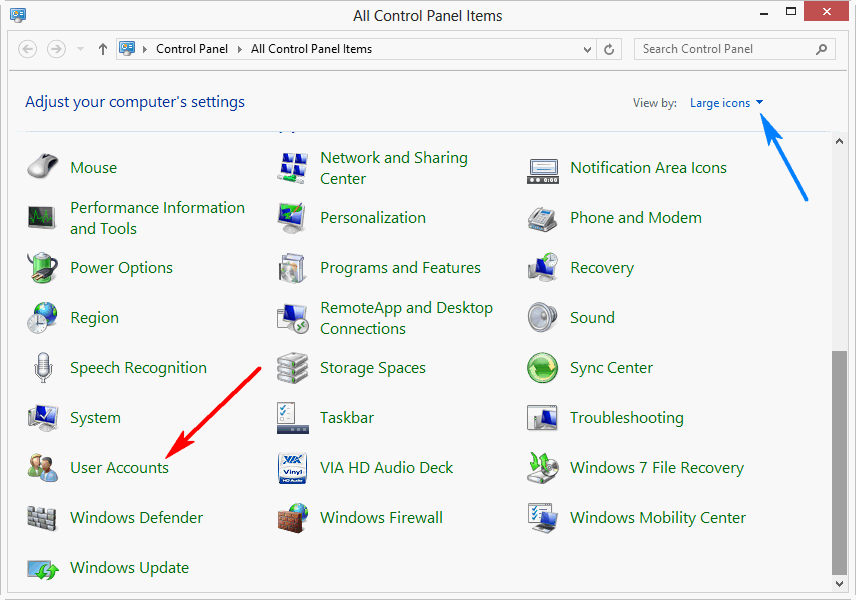
ASUS had changed the default for the the Control Panel to show all the options listed by name with a Large Icon. If your machine displays a list of categories instead, use the pull-down (blue arrow above) to switch to the Large Icon view. What's interesting is that when you do Windows Update Microsoft will sometimes revert the default back to the category view. When you open User Accounts, you see:
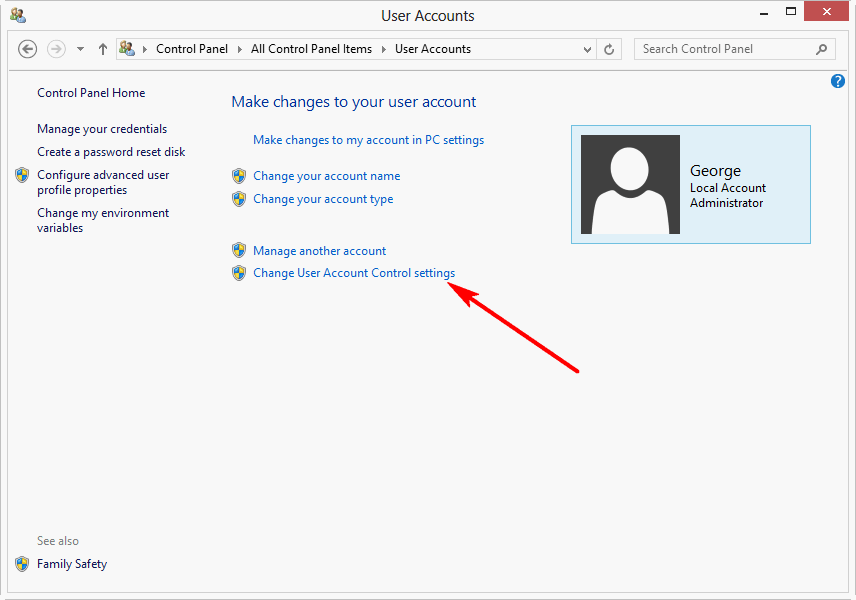
Click on "Turn User Account Control on or off". You then get this dialog:
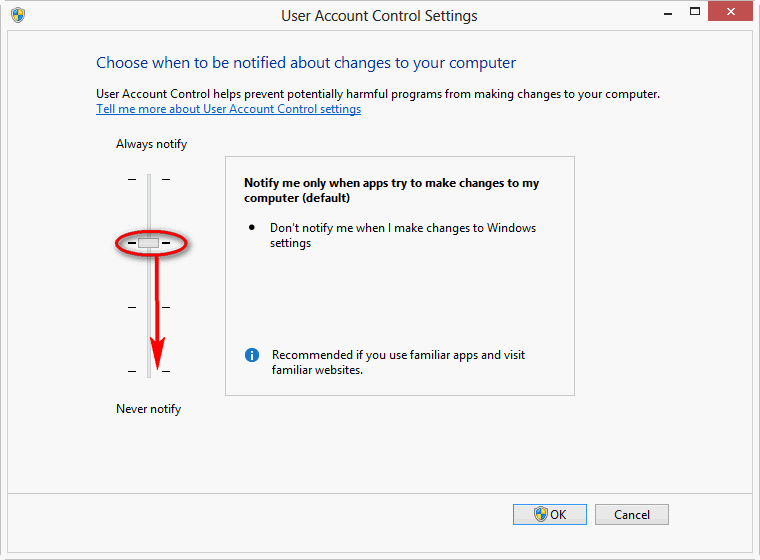
Grab the slider (in the red oval) and slide it down to the bottom. It should then look like this:

As I said this cuts down on a lot of stupid, annoying messages that Microsoft added starting with Vista. In theory they were added to protect you against something outside your machine installing software on it, but they're just a pain and I've NEVER seen them help.
Important: If you only have one hard drive in your machine and it's partitioned into two drives like this machine:
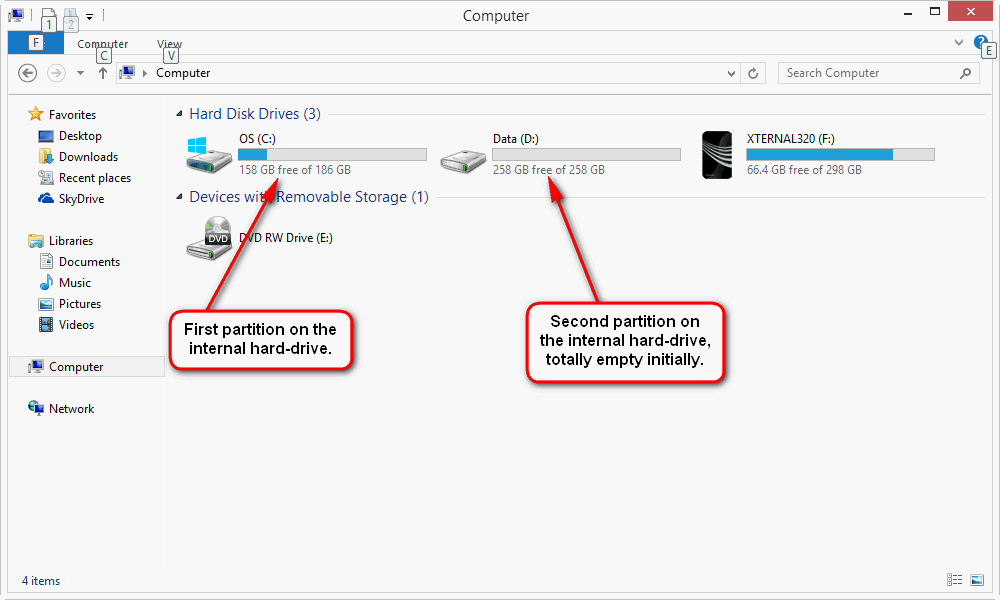
I recommend you follow the directions in the last section, Moving Documents, Pictures, Music and Videos, before transferring data to your new machine.
To control what appears on new start menu you installed, right click on the button it and choose Settings. The options I recommending changing when you installed it are a good starting point, but you might like to refine them over time.
Just like Windows has since XP, the menu keeps track of the programs (and now also Apps) you've used recently and displays them on the start menu list. I don't know why whoever was in charge of Windows 8 thought it was a good idea to get rid of this list.
Note: You can right-click on any program (or icon) in the list to pin it to the menu (place it below the line) and/or the Task Bar. By right-clicking you can also remove programs from the list or un-pin them.
I find this list (which was added in XP) really useful! 98% of the time you'll find the program you're looking for on the this list. When you don't either use the "Search" box just below it, or click on "Programs" or "Apps" and a list of everything installed pops out as it did in older versions of Windows.
Suggested next choices: